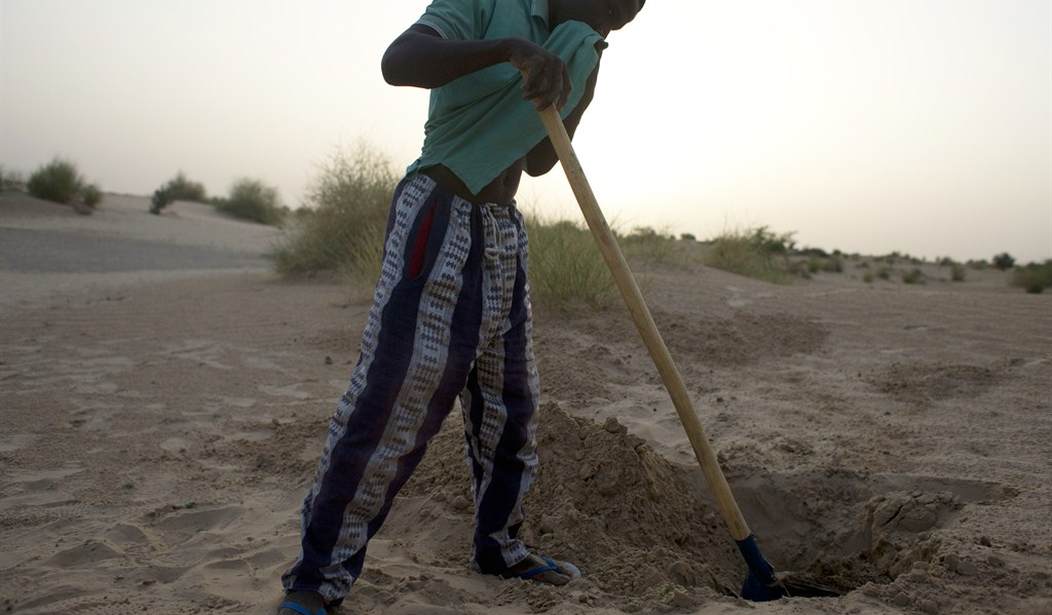Despite recent sporadic rain, California is still in the worst extended drought in its brief recorded history. If more storms do not arrive, the old canard that California could withstand two droughts -- but never three -- will be tested for the first time in memory.
There is little snow in the state's towering Sierra Nevada mountains, the source of much of the surface water that supplies the state's populated center and south. The vast Central Valley aquifer is being tapped as never before, as farms and municipalities deepen wells and boost pump size. Too many straws are now competing to suck out the last drops at the bottom of the collective glass.
The vast 4-million-acre farming belt along the west side of the Central Valley is slowly drying up. Unlike valley agriculture to the east that still has a viable aquifer, these huge farms depend entirely on surface water deliveries from the distant and usually wet northern part of the state. So if the drought continues, billions of dollars of Westside orchards and vineyards will die, row cropland will lay fallow, and farm-supported small towns will likewise dry up.
There is a terrible irony to all this. Never have California farm prices been higher, given huge Pacific export demand. Never have California farmers been more savvy in saving water to produce record harvests of nutritious, clean and safe food. And never has farming been so central to a state suffering from the aftershocks of a housing collapse, chronic high unemployment, overregulation and the nation's highest sales, income and gas taxes.
Recommended
Yet there are really two droughts -- nature's, and its man-made twin. In the early 1980s, when the state was not much more than half its current population, an affluent coastal corridor convinced itself that nirvana was possible, given the coastal world-class universities, the new dot.com riches of the Silicon Valley, the year-round temperate weather, and the booming entertainment, tourism and wine industries.
Apparently, Pacific corridor residents from San Diego to Berkeley had acquired the affluence not to worry so much about the old Neanderthal concerns like keeping up freeways and airports -- and their parents' brilliantly designed system of canals, reservoirs and dams that had turned their state from a natural desert into a man-made paradise. They have become similar to the rarified Eloi of science-fiction writer H.G. Wells' "The Time Machine," who live dreamy existences without any clue how to supply their own daily necessities.
Californians have not built a major reservoir since the New Melones Dam more than 30 years ago. As the state subsequently added almost 20 million people, it assumed that it was exempt from creating any more "unnatural" Sierra lakes and canals to store precious water during California's rarer wet and snow-filled years.
Then, short-sightedness soon became conceit. Green utopians went further and demanded that an ailing 3-inch bait fish in the San Francisco delta receive more fresh oxygenated water. In the last five years, they have successfully gone to court to force millions of acre-feet of contracted irrigation water to be diverted from farms to flow freely out to sea.
Others had even grander ideas of having salmon again in their central rivers, as they recalled fishing stories of their ancestors from when the state population was a fifth of its present size and farming a fraction of its present acreage. So they too sued to divert even more water to the sea in hopes of having game fish swim from the Pacific Ocean up to arid Fresno County on their way to the supposedly ancestral Sierra spawning grounds.
The wages of both nature's drought and human folly are coming due. Unless it rains or snows in biblical fashion in the next 60 days, we could see surreal things in California -- towns without water, farms reverting to scrub, majestic parks with dead landscaping -- fit for Hollywood's disaster movies.
Instead of an adult state with millions of acre-feet stored in new reservoirs, California is still an adolescent culture that believes that it has the right to live as if it were the age of the romantic 19th-century naturalist John Muir -- amid a teeming 40-million-person 21st-century megalopolis.
The California disease is characteristic of comfortable postmodern societies that forget the sources of their original wealth. The state may have the most extensive reserves of gas and oil in the nation, the largest number of cars on the road -- and the greatest resistance to drilling for fuel beneath its collective feet. After last summer's forest fires wiped out a billion board feet of timber, we are still arguing over whether loggers will be allowed to salvage such precious lumber, or instead should let it rot to enhance beetle and woodpecker populations.
In 2014, nature yet again reminded California just how fragile -- and often pretentious -- a place it has become.

























Join the conversation as a VIP Member